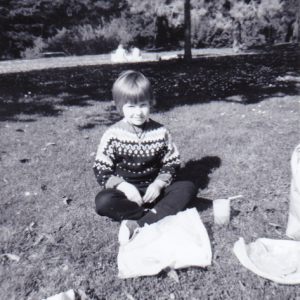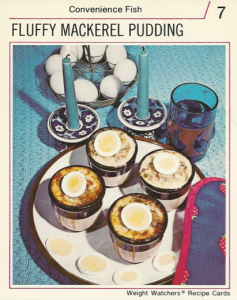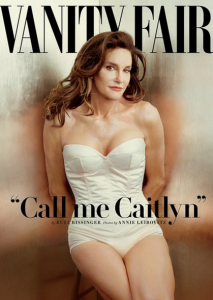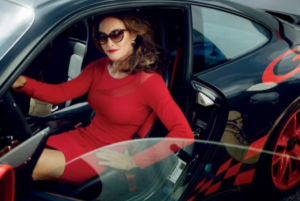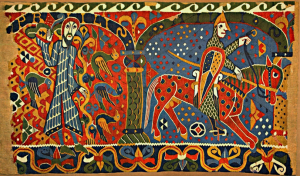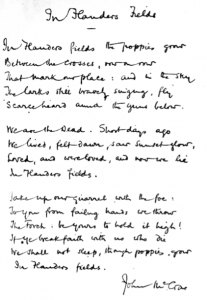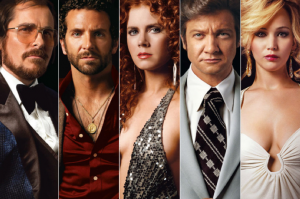
Christian Bale, Bradley Cooper, Amy Adams, Jeremy Renner and Jennifer Lawrence in “American Hustle”
[Originally published on Laura Grey’s Little Hopping Bird blog.]
Of this year’s contenders for the Academy Award for Best Picture, two of the nine feature constant frenetic movement, explosive bursts of speech, uncontrolled intensity of feeling and unrelenting, feverish, heedless action. “American Hustle” and “The Wolf of Wall Street,” both of which are based on true stories about risk-loving con artists, were directed by two of the most lauded and original directors in Hollywood, David O. Russell and Martin Scorsese. Their ability to keep up the hyperactive pace while moving their stories forward with constantly thrumming energy is laudable. There are moments of broad comedy in each movie, and fine actors get to strut and display their big-time acting chops like peacocks. However, the frantic energy of each story kept me from engaging with or feeling much concern for the characters, nearly every one of whom is profoundly, even dangerously, self-absorbed. The manic movement of each story, the outsized and all-consuming appetites of the characters and their frequent disregard for the serious impact their actions had on others made me itch to leave the cinema so I could escape the company of these heedless narcissists.
I have few complaints about the quality of the acting in either film. Each is well cast over all, and the dynamic performers chew their scenery powerfully, bug out their eyes on cue, thrash at each other, spew metaphorical venom and sometimes actual spittle with gusto. They mime their egregious behavior quite capably in scene after scene. But the pace is relentless, the hustle is constant, and the inflated egos bump up against each other with such regularity that I felt they were invading my personal space as well.
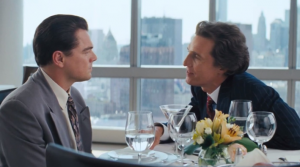
Leonardo DiCaprio and Matthew McConaughey in “The Wolf of Wall Street”
This cinematic overkill, especially “The Wolf of Wall Street,” felt assaultive instead of merely entertaining. These films feature some of the most skilled and intuitive actors in movies today, and I love their fervent energy, which seems to have been the major element that Russell and Scorsese cared about this year. However, I also value these actors for their intuition, for the quiet intensity that each has shown in prior work. Neither film allowed these actors to show this end of their range, and it is range of emotion displayed in a single story that really wows me, not just intense, unbridled feeling overwhelming scene after screaming scene.
We have seen these actors give outstanding performances, so we know what they’re capable of. Christian Bale is a force of nature and has been carrying massive films on his capable shoulders since he was twelve years old. In “Empire of the Sun,” young Bale led an epic Spielberg movie on the strength of his performance and made us believe in and fall in love with him. In “Her,” Amy Adams must convey emotional exhaustion and fragility as well as inner strength and resourcefulness—and she does. In “The Departed,” an undercover cop played by Leonardo DiCaprio lies his way into a dangerous organized crime leader’s inner circle, and seeing the cost to his psyche of living in terror is excruciating. Few actors could play that role with such tormented intensity. In “Silver Linings Playbook,” David O. Russell’s hugely successful and moving Best Picture nominee from just last year, Jennifer Lawrence and Bradley Cooper are misfits with huge hearts and huge tempers. They hunger but hold back, explode and then retreat. They bob and weave and engage, connect and then just miss each other. The audience shares in their yearning to find a safe harbor in each other.
But in “American Hustle,” the actors rush at each other, scream and punch, and the mascara runs, the hair gets pulled, and the poor Steadicam operator whirls in 360-degree circles to amplify the mayhem going on around him because of the intense, no-holds-barred way in which Russell films his movies. In “The Wolf of Wall Street,” Scorsese overloads us with scene after scene of excess: offices filled with screaming, raving, swearing stock traders oozing testosterone and pumping fists, anxious to defraud any patsy they come across; hotel rooms full of hookers and blow; drug-fueled orgy scenes so full of outlandish spectacle that our eyes roam wildly over the screen as we try to focus on a single episode of decadence at a time. It all blurs together in a giant Quaalude-fueled, Armani-clad, cocaine-covered slurry of outrageous excess.
There are rich and enjoyable scenes in each film, of course. “American Hustle” was written by David O. Russell and Eric Warren Singer; “The Wolf of Wall Street” was penned by Terrence Winter, creator of “Boardwalk Empire” and frequent writer and producer of “The Sopranos.” Both provide lively, vulgar, rapid-fire dialog, and their actors relish every syllable. Jennifer Lawrence’s drunken, desperate, boundary-free turn as con man Christian Bale’s wife Rosalyn in “American Hustle” is a knock-out performance. She mixes cockiness with desperation as she warns Amy Adams’s character to stay away from her man, and she struts, lures and confronts with stunning confidence and charisma. Lawrence has the instincts and impeccable timing (both dramatic and comedic) of a much more experienced actress. Her performance makes it clear that having won a Best Actress Oscar last year (with the same director and one of the same co-stars) with a self-assured performance at such an early age was no fluke.
Amy Adams’s performance here is less successful. She’s a talented actress and a very likeable woman; her interview with James Lipton on Bravo’s “Inside the Actor’s Studio” last month showed her to be a thoughtful, disciplined, generous actor, articulate and devoted to her craft and to those with whom she works. But I never bought her in her role as Sydney, a lying, manipulative homewrecker with nerves of steel who is vital to the con artistry involved in bringing down corrupt politicians. She brings a quiver and insecurity to all her roles which often gives them a spark of life, but here that vulnerability undermines the ruthlessness of her character. The British accent she adopts for part of the film was so uneven and unconvincing I could never believe that any character would buy it; throughout the film I was always aware that she was a playing a role. Adams has a natural softness that suits her well in most of her films, and while she was surprisingly effective as a foul-mouthed barmaid in Russell’s earlier and extremely entertaining film, “The Fighter,” here she plays too much against type. Her character in “American Hustle” is so conniving and happy to use any and everyone that she left me cold—like nearly every other character in this over-adrenalized movie.
However, I do applaud Russell for providing rich and chewy roles for women in most of his films, roles that allow women to be as lively, influential, exciting and messed up as the men. Scorsese’s films are usually all about the men, and in “Wolf of Wall Street,” the women are again primarily foils for stories about over-grown boys gone very, very bad.
Bradley Cooper shows angst and confused anger as well as anyone; he used these skills to great effect in “Silver Linings Playbook,” behaving erratically and often badly without losing our sympathy. In “American Hustle,” his character is so violent, duplicitous, vain and selfish that despite the good performance, I couldn’t care about him and didn’t enjoy spending time with his portrayal of nasty, erratic FBI agent Richie. Similarly, Christian Bale (whose Oscar-winning performance in Russell’s film “The Fighter” was sensational) gained over 40 pounds and sported the worst comb-over in the history of cinema to become Irving for this film. While he has more heart than the rest and even experiences moments of regret, those fleeting episodes of conscience rarely interfere with his putting his interests first. Jeremy Renner’s portrayal of Mayor Carmine Polito is one of the more sympathetic characters here, but when the lying, law-breaking politician is one of the better-behaved members of the ensemble, you know you’re hanging out with the wrong people.
The behavior is even more outrageous and consideration for the safety or well-being of others is completely lacking in “The Wolf of Wall Street.” As in “American Hustle,” the story is told in a nonjudgmental way; indeed, in the character of Jordan Belfort, a corrupt stockbroker who was convicted of market manipulation and fraud, Leonardo DiCaprio narrates the story of his rise and fall himself. Audacious behaviors that threaten people’s livelihoods and even lives are presented as sources of amusement and are seen as sexy and exciting. Matthew McConaughey’s cameo early in the film as an enthusiastically despicable character is heartily enjoyable, but what seemed like over-the-top self-absorption in that scene proved to be reined in and subtle compared to the rip-snortingly outrageous fever pitch the film builds to over the following two hours. Jonah Hill plays DiCaprio’s sidekick Donnie Azoff with relish and delight; Donnie provides much of the comic relief of the film, but Hill plays him not just as a clown but as a man in over his head. Donnie was clearly not born with the gifts of suave, slick, sick-hearted Jordan, so watching his decline hurts more than seeing Jordan’s fall. For dramatic purposes, Terrence Winter was wise to emphasize the relationship between these two men above all others in this film since there is a strange and interesting chemistry between them, but I notice that, again, Scorsese has chosen to present a story in which women are noticeably peripheral to the action, except as sexy visual filler.
Scorsese is an interesting case; he is capable of great restraint and beauty in a film like “The Age of Innocence,” and even his most volatile and violent characters live in worlds that are beautifully designed, lit and filmed. He has one of the most aesthetically sophisticated points of view of any director working today, and we owe him an enormous debt of gratitude for his many years of efforts to support film preservation. But his enthusiasm for extremes of behavior and expression, and his desire to make viewers not only experience but wallow in assaultive excess, cause me to view his work with a wary eye. Much as I admire a Scorsese classic like “Goodfellas” and admire his guiding touch in the excellent HBO series “Boardwalk Empire,” I must always prepare myself for a barrage of ugliness when I enter a cinema that presents his films, for violence is inherent to most of his greatest work. He is famed for working with the meticulous editor Thelma Schoonmaker, and they certainly know how to build tension. But fine filmmaking involves more than bottling up rage until it is compressed to such a point that the bottle shatters. Nobody does explosive rage better than Scorsese, but in his latest film, he does it at the expense of the quieter moments that allow an audience to breathe, to relax, and to get inside the workings of a character so that we can feel enough about him or her to care when something happens to change his or her world. In this film he works more in words than in blood, it’s true, yet the energy behind the story feels as violent and visceral as the energy in his more deadly works.
My favorite Scorsese film, “The Departed,” features a crackerjack cast (Jack Nicholson, Matt Damon, Mark Wahlberg, Alec Baldwin, Martin Sheen, Vera Farmiga), including one of the director’s favorite actors, Leonardo DiCaprio. Leo has become to Scorsese what Robert De Niro was to the director’s earlier films. He is at his best when he channels his vulnerability alongside his rage; we must see the bruised boy within the powerful men he usually plays in order to be drawn into and care about his characters. In “The Wolf of Wall Street,” he has a chance to express his explosive power unchecked, and it’s damned impressive, but the role misses the element that makes DiCaprio a truly great actor: his range, his fragile core, the pain his characters generally feel when they harm others. His performance here is powerfully ugly, and the character moves along his nasty trajectory so quickly that we get very little time with him before he becomes a monster. DiCaprio deserved his Best Supporting Actor Oscar nomination (and perhaps the Oscar itself) for his amazing work in “What’s Eating Gilbert Grape?” and gave exceptional performances in “Revolutionary Road” and “The Departed” and wildly entertaining performances in “The Aviator,” “Catch Me if You Can” and other fine films. But “The Wolf of Wall Street” is not the film he should win his first Oscar for.
DiCaprio, like Christian Bale, is one of the finest actors of his generation, and Leo is, over all, a more versatile performer than Matthew McConaughey, who has proven his own mettle over the past four years. However, McConaughey’s performance in “Dallas Buyers Club” is the more moving and astonishing feat of acting; his is the performance I would like to see win a Best Actor Oscar this year. In “Dallas Buyers Club” he was able to show range, raw vulnerability, and a talent that moves from abject deathly illness and despair to victorious, cocky success, all in a brittle, emaciated body that is as far as a man can get from the muscled, oiled, powerful physique he displayed in “Magic Mike” just two years ago. Christian Bale is a remarkably realistic actor, and he gives his all here, but the character is limited in his range of emotion and expression as well. Bale whispers, shouts, cajoles and generally shows much more versatility that the other actors in “American Hustle” are allowed, but his role cannot provide us with a breathtaking conversion from lost soul to redeemed hero the way McConaughey does in “Dallas Buyers Club.” I don’t blame DiCaprio or Bale for not being worthy of Oscars this year; they did what they were hired to do admirably and often enjoyably, but they did not have the opportunity to reinvent themselves on the scale that McConaughey did, and he proved himself as adept and committed any actor alive.
As explosive as the characters directed by Scorsese can be, director David O. Russell is famous for his own scary relationship to anger. He was involved in two of the most famous altercations in movie-making history with two of Hollywood’s best-loved movie stars. His ego and temper are legendary. During the making of his wickedly funny, surprisingly moving war film “Three Kings,” George Clooney was so appalled by Russell’s contemptuous treatment of the film’s crew that Clooney and Russell got into an argument so heated it broke down into physical fighting between the star and the director. During the making of his mediocre film “I Heart Huckabee’s,” Lily Tomlin, with whom Russell worked successfully in the funny road-movie farce “Flirting with Disaster,” found Russell and his style so difficult to work with that their disagreement quickly rose to a shouting match that was recorded and shared widely the world over. They’ve since made up with each other, and in his interviews (as well as in most of his films) he shows a self-deprecating wit, enthusiasm, devotion to craft and (occasional) sensitivity that allow one to see how all-consuming his passion for movie-making is, and how difficult it has been for him to allow a single element of it to elude his control. He is still famously touchy, tightly coiled and sometimes turns adversarial with surprising speed. However, with his great recent success he seems to have learned some element of humility; he credits his becoming more patient and loving to the fact of his having a severely bi-polar son for whom he has had to sacrifice much. He says it was his experience with his son that drove him to make “Silver Linings Playbook,” and he certainly brought great love and passion to that project, which deserves its great success.
Perhaps it was his having moderated his expression of anger in his private life that led Russell to find an appropriate professional outlet for his extremes of emotion and led to the boisterous “American Hustle.” As many reviewers adore the film as were overwhelmed by it. Audiences were certainly seduced by the disco-era costumes, interiors and, especially, hairstyles; it is a visual feast of seventies tackiness. But it is the film’s energy level that either delights or repels audiences the most. Russell works differently from most directors, and that shows up on the screen. Jennifer Lawrence calls Russell’s style “weird and instantaneous,” Robert De Niro says it’s “spontaneous and chaotic.” Russell likes to film in enclosed spaces and to use a Steadicam (hand-held camera) operator to follow the action around the room (or even inside a car) and to film multiple takes of a scene in quick succession without turning off the camera. Actors have to keep their energy levels up and their characters intact because at any moment they might have to repeat, react to, change the dialog in or continue a scene without knowing in advance. (This process is what Lily Tomlin found so unnerving during the filming of “I Heart Huckabees.”) Some find it exhilarating, and the energy certainly shows up on the screen. David Denby of the New Yorker says, “‘American Hustle’ is built around many acts of cynical manipulation, but it is generous, even kindly, in spirit. … What he puts on the screen here is faster than life and more volatile than common realism, but it’s definitely not farce. His characters act stupidly because they want something desperately, and his actors, all of them taking enormous risks, form an ensemble that is the equal of anything from Hollywood’s golden age.”
I did not find it so. I was able to enjoy some of the film as it progressed, but the more I think about it in retrospect, the more it disappoints me. The selfishness of nearly every character wore me down and left me cold. Because the script for “American Hustle” bounces from one fraught, intense scene to the next, the viewer never gets to relax, either. I found this frenetic pace, along with the inherently unlikable qualities of the characters, distanced me from them and made me weary of all the niggling details of their exchanges. The film is ostensibly about the famous Abscam sting operation run by the FBI in the 1970s. The operation set up and entrapped public officials who were on the take by involving known swindlers working on behalf of the government. Since a story that relies on backroom political bribery is not always inherently gripping, the real heart of the film is in the personal entanglements between the people who entrapped the politicians and their motivations for doing such work. I found the explanations of these intrigues overly detailed and the histrionics of the five primary characters tiring enough that I started checking my watch halfway through the film. I was relieved to see Louis C.K. portray the only reasonable, normal person on screen, but Bradley Cooper as the FBI agent treated him so badly that I began to cringe in anticipation every time Louis’s face appeared. Christian Bale’s character, for all his many flaws, is the only one who shows actual concern for the people he harms along the way, but it came too little and too late for me to enjoy his characterization much.
There is more to a great film than the alternation of emotional compression and explosive rage, and there is more to a great director than the ability to prod an actor into spewing and screaming. While I look forward to future projects from all of the actors, writers and directors involved in these films, I hope that at this year’s Academy Award ceremony their directors are not rewarded for these exhausting, overwrought paeans to excess.

